A Report on Child Abuse and its Protection Under UK Legislations
VerifiedAdded on 2023/05/27
|13
|3128
|180
Report
AI Summary
This report provides an overview of child abuse and its protection in the UK, highlighting the absence of a single comprehensive legislation but rather a collection of laws aimed at safeguarding children. It discusses the roles of local authorities and nonprofit organizations in prevention and intervention. A case study involving Saryah and her siblings is presented to illustrate various risk factors, including neglect, physical abuse, emotional abuse, and educational deprivation. The report further explores the impact of abuse and neglect on children's emotional, behavioral, and mental health, as well as their social skills and educational outcomes. Recommendations are made, including providing shelter, regular visits by local authorities, forming multidisciplinary teams, offering educational and emotional support, and utilizing provisions under the Working Together to Safeguard Children 2015. Legal actions under the Children Act 1989 are also discussed, emphasizing the importance of interim care orders and continued support for families to ensure the well-being of children. The report concludes by stressing the need for careful monitoring and adherence to agreed premises to protect children from abuse and neglect.
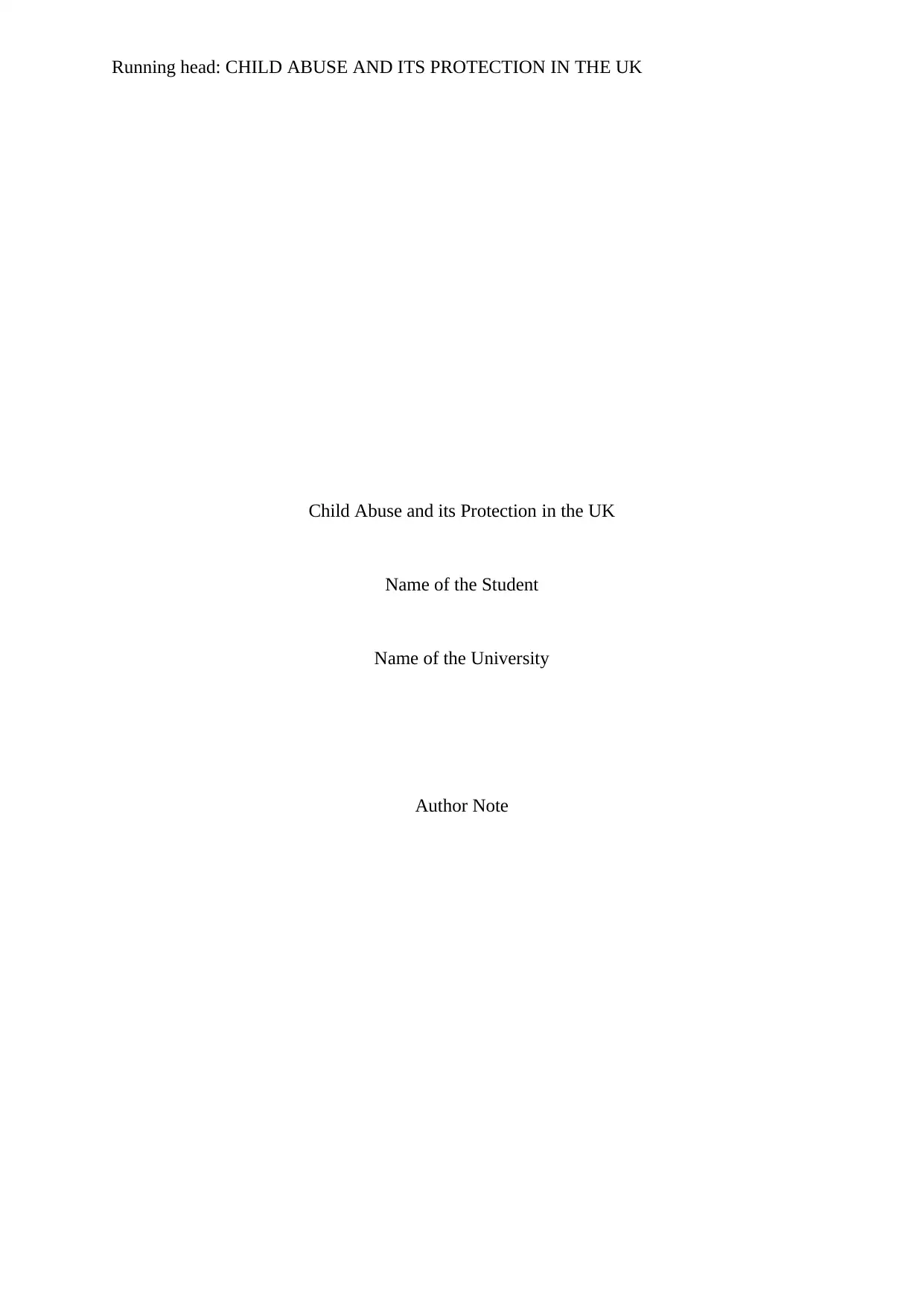
Running head: CHILD ABUSE AND ITS PROTECTION IN THE UK
Child Abuse and its Protection in the UK
Name of the Student
Name of the University
Author Note
Child Abuse and its Protection in the UK
Name of the Student
Name of the University
Author Note
Paraphrase This Document
Need a fresh take? Get an instant paraphrase of this document with our AI Paraphraser
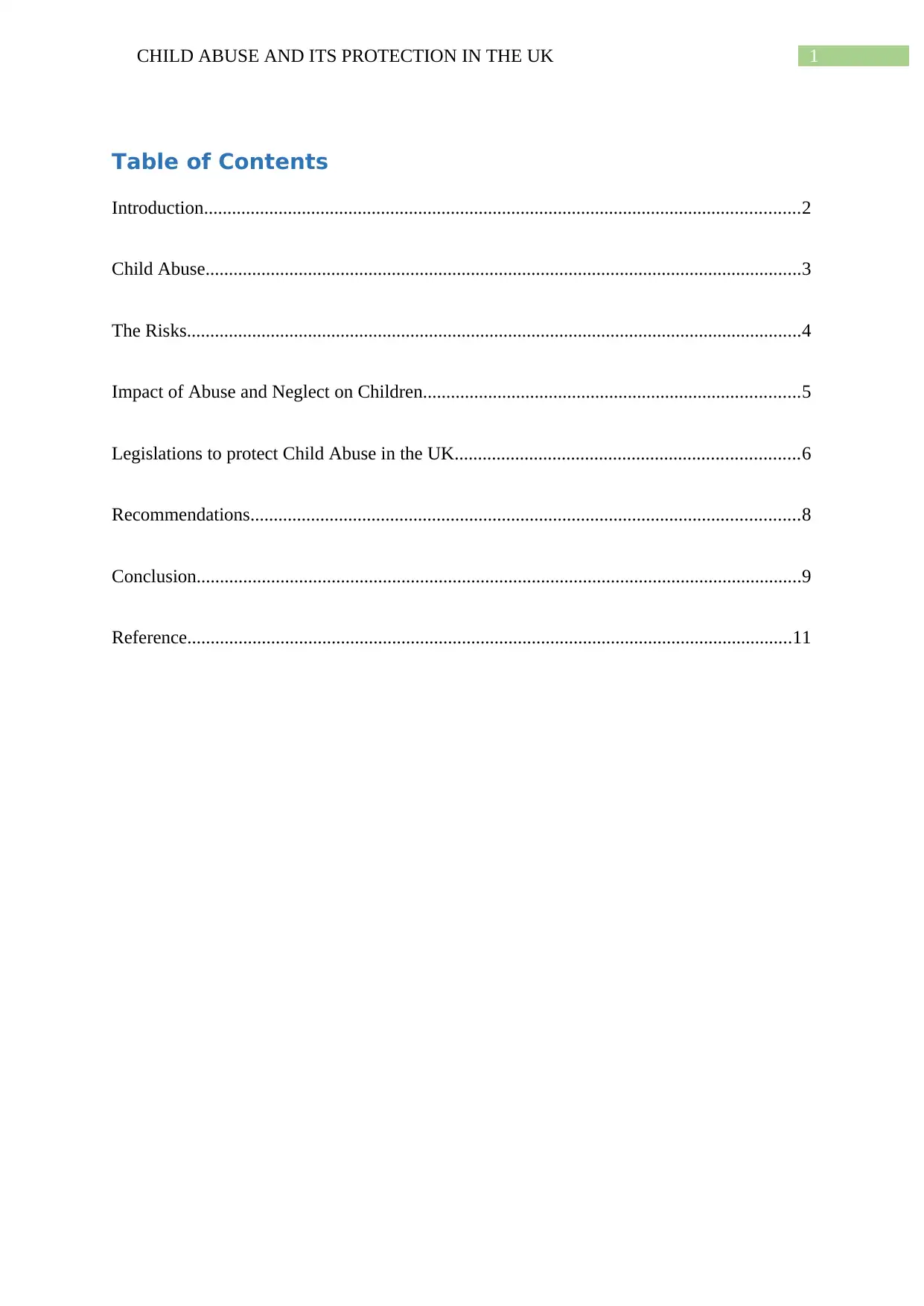
1CHILD ABUSE AND ITS PROTECTION IN THE UK
Table of Contents
Introduction................................................................................................................................2
Child Abuse................................................................................................................................3
The Risks....................................................................................................................................4
Impact of Abuse and Neglect on Children.................................................................................5
Legislations to protect Child Abuse in the UK..........................................................................6
Recommendations......................................................................................................................8
Conclusion..................................................................................................................................9
Reference..................................................................................................................................11
Table of Contents
Introduction................................................................................................................................2
Child Abuse................................................................................................................................3
The Risks....................................................................................................................................4
Impact of Abuse and Neglect on Children.................................................................................5
Legislations to protect Child Abuse in the UK..........................................................................6
Recommendations......................................................................................................................8
Conclusion..................................................................................................................................9
Reference..................................................................................................................................11
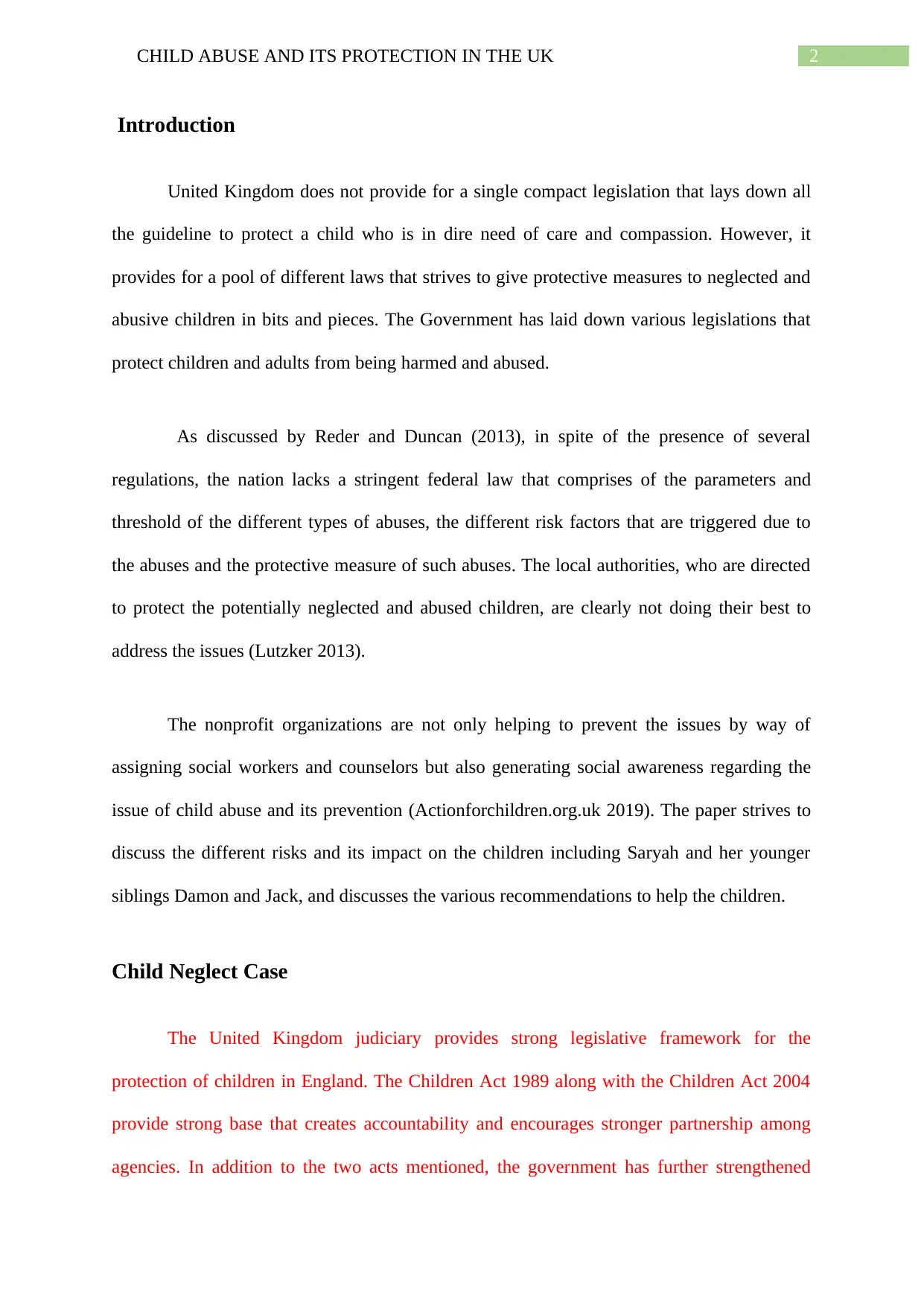
2CHILD ABUSE AND ITS PROTECTION IN THE UK
Introduction
United Kingdom does not provide for a single compact legislation that lays down all
the guideline to protect a child who is in dire need of care and compassion. However, it
provides for a pool of different laws that strives to give protective measures to neglected and
abusive children in bits and pieces. The Government has laid down various legislations that
protect children and adults from being harmed and abused.
As discussed by Reder and Duncan (2013), in spite of the presence of several
regulations, the nation lacks a stringent federal law that comprises of the parameters and
threshold of the different types of abuses, the different risk factors that are triggered due to
the abuses and the protective measure of such abuses. The local authorities, who are directed
to protect the potentially neglected and abused children, are clearly not doing their best to
address the issues (Lutzker 2013).
The nonprofit organizations are not only helping to prevent the issues by way of
assigning social workers and counselors but also generating social awareness regarding the
issue of child abuse and its prevention (Actionforchildren.org.uk 2019). The paper strives to
discuss the different risks and its impact on the children including Saryah and her younger
siblings Damon and Jack, and discusses the various recommendations to help the children.
Child Neglect Case
The United Kingdom judiciary provides strong legislative framework for the
protection of children in England. The Children Act 1989 along with the Children Act 2004
provide strong base that creates accountability and encourages stronger partnership among
agencies. In addition to the two acts mentioned, the government has further strengthened
Introduction
United Kingdom does not provide for a single compact legislation that lays down all
the guideline to protect a child who is in dire need of care and compassion. However, it
provides for a pool of different laws that strives to give protective measures to neglected and
abusive children in bits and pieces. The Government has laid down various legislations that
protect children and adults from being harmed and abused.
As discussed by Reder and Duncan (2013), in spite of the presence of several
regulations, the nation lacks a stringent federal law that comprises of the parameters and
threshold of the different types of abuses, the different risk factors that are triggered due to
the abuses and the protective measure of such abuses. The local authorities, who are directed
to protect the potentially neglected and abused children, are clearly not doing their best to
address the issues (Lutzker 2013).
The nonprofit organizations are not only helping to prevent the issues by way of
assigning social workers and counselors but also generating social awareness regarding the
issue of child abuse and its prevention (Actionforchildren.org.uk 2019). The paper strives to
discuss the different risks and its impact on the children including Saryah and her younger
siblings Damon and Jack, and discusses the various recommendations to help the children.
Child Neglect Case
The United Kingdom judiciary provides strong legislative framework for the
protection of children in England. The Children Act 1989 along with the Children Act 2004
provide strong base that creates accountability and encourages stronger partnership among
agencies. In addition to the two acts mentioned, the government has further strengthened
⊘ This is a preview!⊘
Do you want full access?
Subscribe today to unlock all pages.

Trusted by 1+ million students worldwide
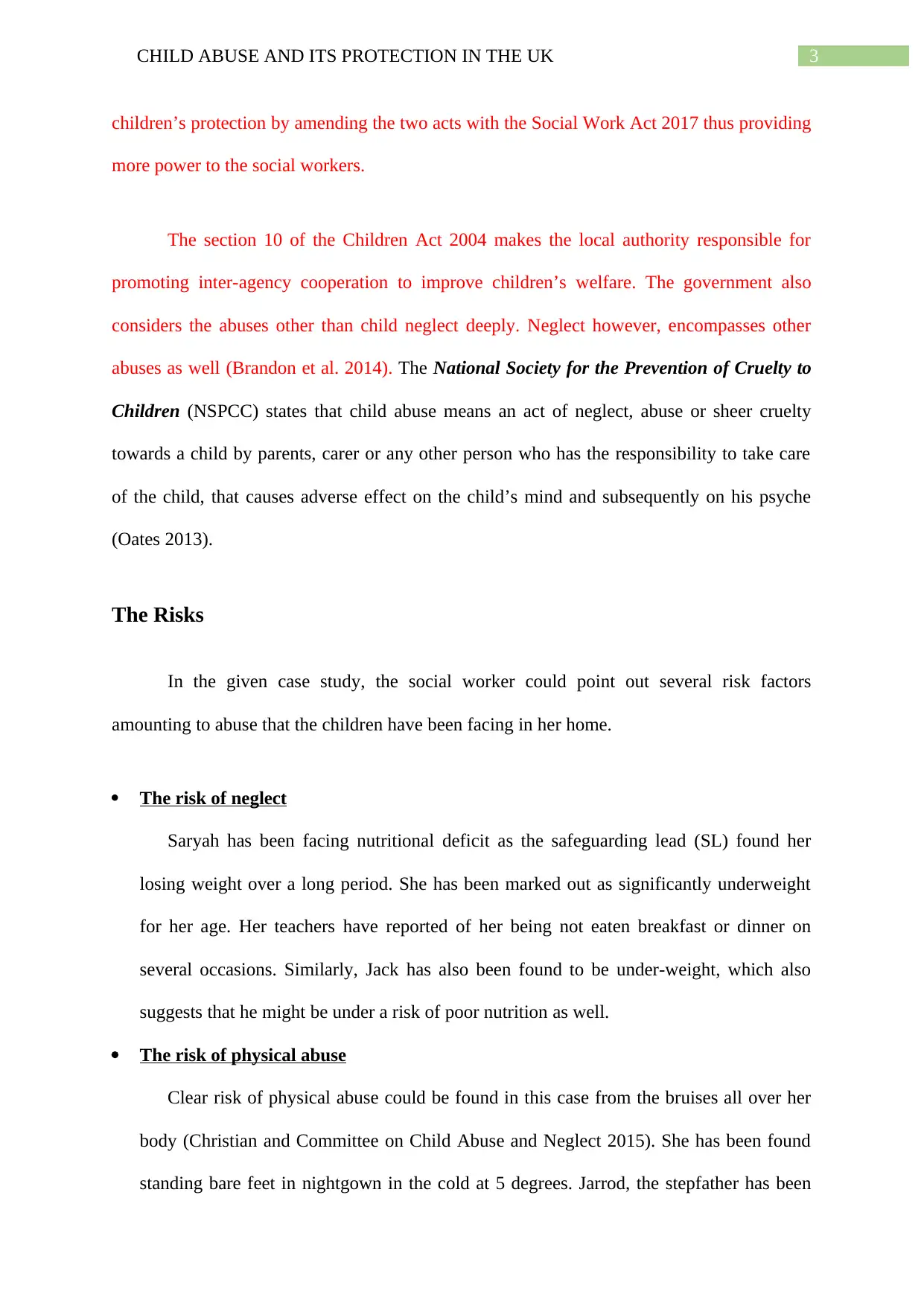
3CHILD ABUSE AND ITS PROTECTION IN THE UK
children’s protection by amending the two acts with the Social Work Act 2017 thus providing
more power to the social workers.
The section 10 of the Children Act 2004 makes the local authority responsible for
promoting inter-agency cooperation to improve children’s welfare. The government also
considers the abuses other than child neglect deeply. Neglect however, encompasses other
abuses as well (Brandon et al. 2014). The National Society for the Prevention of Cruelty to
Children (NSPCC) states that child abuse means an act of neglect, abuse or sheer cruelty
towards a child by parents, carer or any other person who has the responsibility to take care
of the child, that causes adverse effect on the child’s mind and subsequently on his psyche
(Oates 2013).
The Risks
In the given case study, the social worker could point out several risk factors
amounting to abuse that the children have been facing in her home.
The risk of neglect
Saryah has been facing nutritional deficit as the safeguarding lead (SL) found her
losing weight over a long period. She has been marked out as significantly underweight
for her age. Her teachers have reported of her being not eaten breakfast or dinner on
several occasions. Similarly, Jack has also been found to be under-weight, which also
suggests that he might be under a risk of poor nutrition as well.
The risk of physical abuse
Clear risk of physical abuse could be found in this case from the bruises all over her
body (Christian and Committee on Child Abuse and Neglect 2015). She has been found
standing bare feet in nightgown in the cold at 5 degrees. Jarrod, the stepfather has been
children’s protection by amending the two acts with the Social Work Act 2017 thus providing
more power to the social workers.
The section 10 of the Children Act 2004 makes the local authority responsible for
promoting inter-agency cooperation to improve children’s welfare. The government also
considers the abuses other than child neglect deeply. Neglect however, encompasses other
abuses as well (Brandon et al. 2014). The National Society for the Prevention of Cruelty to
Children (NSPCC) states that child abuse means an act of neglect, abuse or sheer cruelty
towards a child by parents, carer or any other person who has the responsibility to take care
of the child, that causes adverse effect on the child’s mind and subsequently on his psyche
(Oates 2013).
The Risks
In the given case study, the social worker could point out several risk factors
amounting to abuse that the children have been facing in her home.
The risk of neglect
Saryah has been facing nutritional deficit as the safeguarding lead (SL) found her
losing weight over a long period. She has been marked out as significantly underweight
for her age. Her teachers have reported of her being not eaten breakfast or dinner on
several occasions. Similarly, Jack has also been found to be under-weight, which also
suggests that he might be under a risk of poor nutrition as well.
The risk of physical abuse
Clear risk of physical abuse could be found in this case from the bruises all over her
body (Christian and Committee on Child Abuse and Neglect 2015). She has been found
standing bare feet in nightgown in the cold at 5 degrees. Jarrod, the stepfather has been
Paraphrase This Document
Need a fresh take? Get an instant paraphrase of this document with our AI Paraphraser
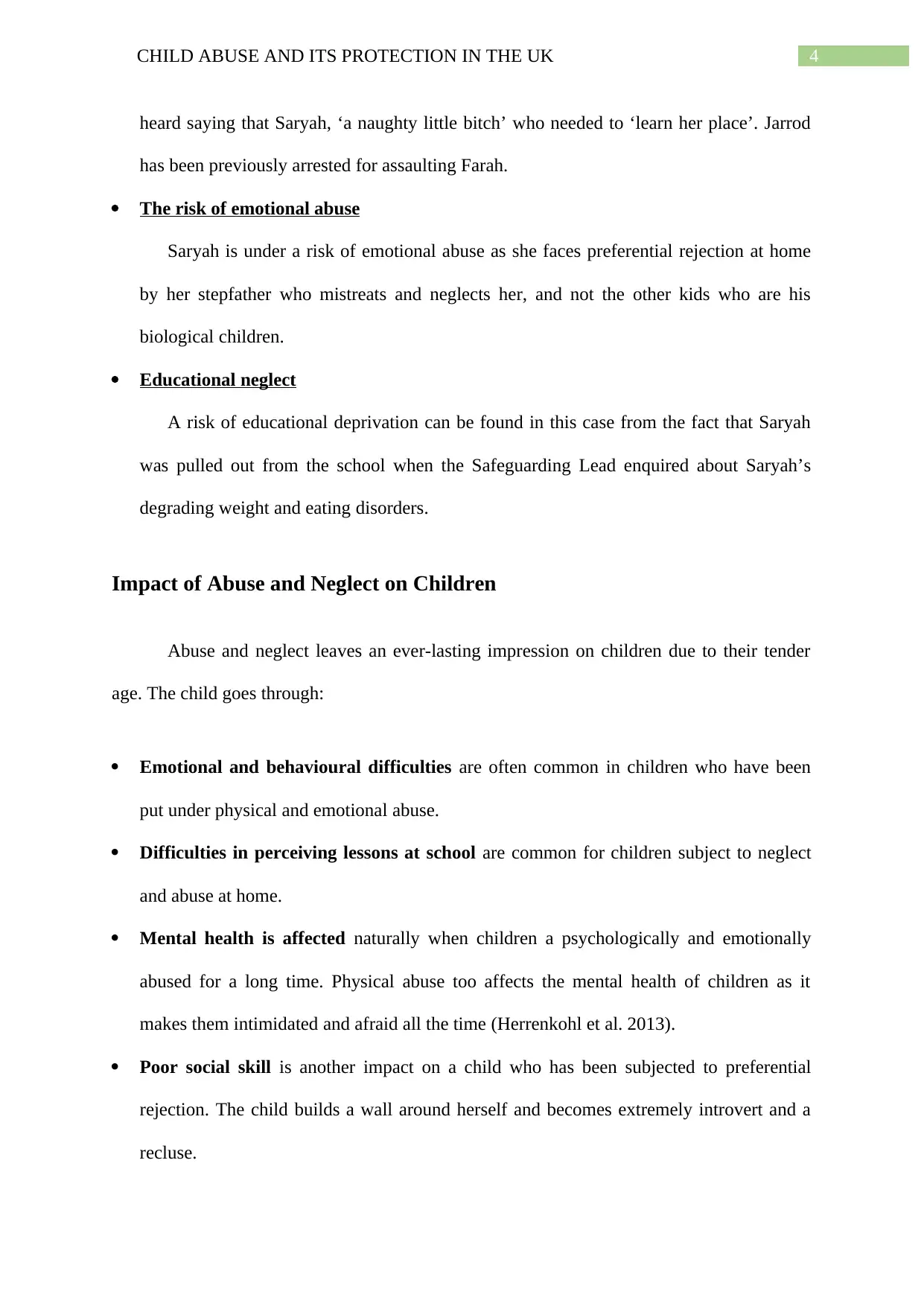
4CHILD ABUSE AND ITS PROTECTION IN THE UK
heard saying that Saryah, ‘a naughty little bitch’ who needed to ‘learn her place’. Jarrod
has been previously arrested for assaulting Farah.
The risk of emotional abuse
Saryah is under a risk of emotional abuse as she faces preferential rejection at home
by her stepfather who mistreats and neglects her, and not the other kids who are his
biological children.
Educational neglect
A risk of educational deprivation can be found in this case from the fact that Saryah
was pulled out from the school when the Safeguarding Lead enquired about Saryah’s
degrading weight and eating disorders.
Impact of Abuse and Neglect on Children
Abuse and neglect leaves an ever-lasting impression on children due to their tender
age. The child goes through:
Emotional and behavioural difficulties are often common in children who have been
put under physical and emotional abuse.
Difficulties in perceiving lessons at school are common for children subject to neglect
and abuse at home.
Mental health is affected naturally when children a psychologically and emotionally
abused for a long time. Physical abuse too affects the mental health of children as it
makes them intimidated and afraid all the time (Herrenkohl et al. 2013).
Poor social skill is another impact on a child who has been subjected to preferential
rejection. The child builds a wall around herself and becomes extremely introvert and a
recluse.
heard saying that Saryah, ‘a naughty little bitch’ who needed to ‘learn her place’. Jarrod
has been previously arrested for assaulting Farah.
The risk of emotional abuse
Saryah is under a risk of emotional abuse as she faces preferential rejection at home
by her stepfather who mistreats and neglects her, and not the other kids who are his
biological children.
Educational neglect
A risk of educational deprivation can be found in this case from the fact that Saryah
was pulled out from the school when the Safeguarding Lead enquired about Saryah’s
degrading weight and eating disorders.
Impact of Abuse and Neglect on Children
Abuse and neglect leaves an ever-lasting impression on children due to their tender
age. The child goes through:
Emotional and behavioural difficulties are often common in children who have been
put under physical and emotional abuse.
Difficulties in perceiving lessons at school are common for children subject to neglect
and abuse at home.
Mental health is affected naturally when children a psychologically and emotionally
abused for a long time. Physical abuse too affects the mental health of children as it
makes them intimidated and afraid all the time (Herrenkohl et al. 2013).
Poor social skill is another impact on a child who has been subjected to preferential
rejection. The child builds a wall around herself and becomes extremely introvert and a
recluse.
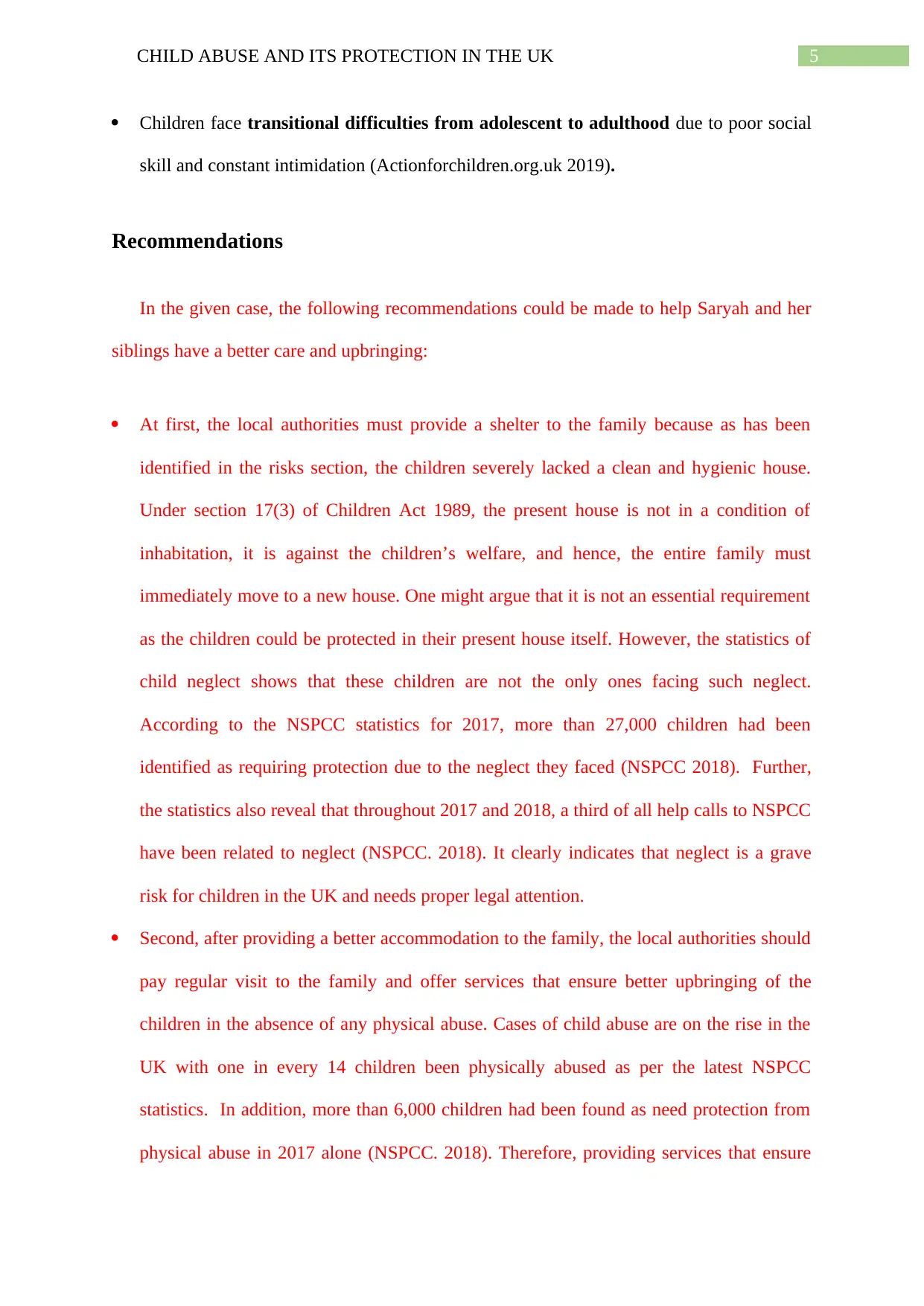
5CHILD ABUSE AND ITS PROTECTION IN THE UK
Children face transitional difficulties from adolescent to adulthood due to poor social
skill and constant intimidation (Actionforchildren.org.uk 2019).
Recommendations
In the given case, the following recommendations could be made to help Saryah and her
siblings have a better care and upbringing:
At first, the local authorities must provide a shelter to the family because as has been
identified in the risks section, the children severely lacked a clean and hygienic house.
Under section 17(3) of Children Act 1989, the present house is not in a condition of
inhabitation, it is against the children’s welfare, and hence, the entire family must
immediately move to a new house. One might argue that it is not an essential requirement
as the children could be protected in their present house itself. However, the statistics of
child neglect shows that these children are not the only ones facing such neglect.
According to the NSPCC statistics for 2017, more than 27,000 children had been
identified as requiring protection due to the neglect they faced (NSPCC 2018). Further,
the statistics also reveal that throughout 2017 and 2018, a third of all help calls to NSPCC
have been related to neglect (NSPCC. 2018). It clearly indicates that neglect is a grave
risk for children in the UK and needs proper legal attention.
Second, after providing a better accommodation to the family, the local authorities should
pay regular visit to the family and offer services that ensure better upbringing of the
children in the absence of any physical abuse. Cases of child abuse are on the rise in the
UK with one in every 14 children been physically abused as per the latest NSPCC
statistics. In addition, more than 6,000 children had been found as need protection from
physical abuse in 2017 alone (NSPCC. 2018). Therefore, providing services that ensure
Children face transitional difficulties from adolescent to adulthood due to poor social
skill and constant intimidation (Actionforchildren.org.uk 2019).
Recommendations
In the given case, the following recommendations could be made to help Saryah and her
siblings have a better care and upbringing:
At first, the local authorities must provide a shelter to the family because as has been
identified in the risks section, the children severely lacked a clean and hygienic house.
Under section 17(3) of Children Act 1989, the present house is not in a condition of
inhabitation, it is against the children’s welfare, and hence, the entire family must
immediately move to a new house. One might argue that it is not an essential requirement
as the children could be protected in their present house itself. However, the statistics of
child neglect shows that these children are not the only ones facing such neglect.
According to the NSPCC statistics for 2017, more than 27,000 children had been
identified as requiring protection due to the neglect they faced (NSPCC 2018). Further,
the statistics also reveal that throughout 2017 and 2018, a third of all help calls to NSPCC
have been related to neglect (NSPCC. 2018). It clearly indicates that neglect is a grave
risk for children in the UK and needs proper legal attention.
Second, after providing a better accommodation to the family, the local authorities should
pay regular visit to the family and offer services that ensure better upbringing of the
children in the absence of any physical abuse. Cases of child abuse are on the rise in the
UK with one in every 14 children been physically abused as per the latest NSPCC
statistics. In addition, more than 6,000 children had been found as need protection from
physical abuse in 2017 alone (NSPCC. 2018). Therefore, providing services that ensure
⊘ This is a preview!⊘
Do you want full access?
Subscribe today to unlock all pages.

Trusted by 1+ million students worldwide
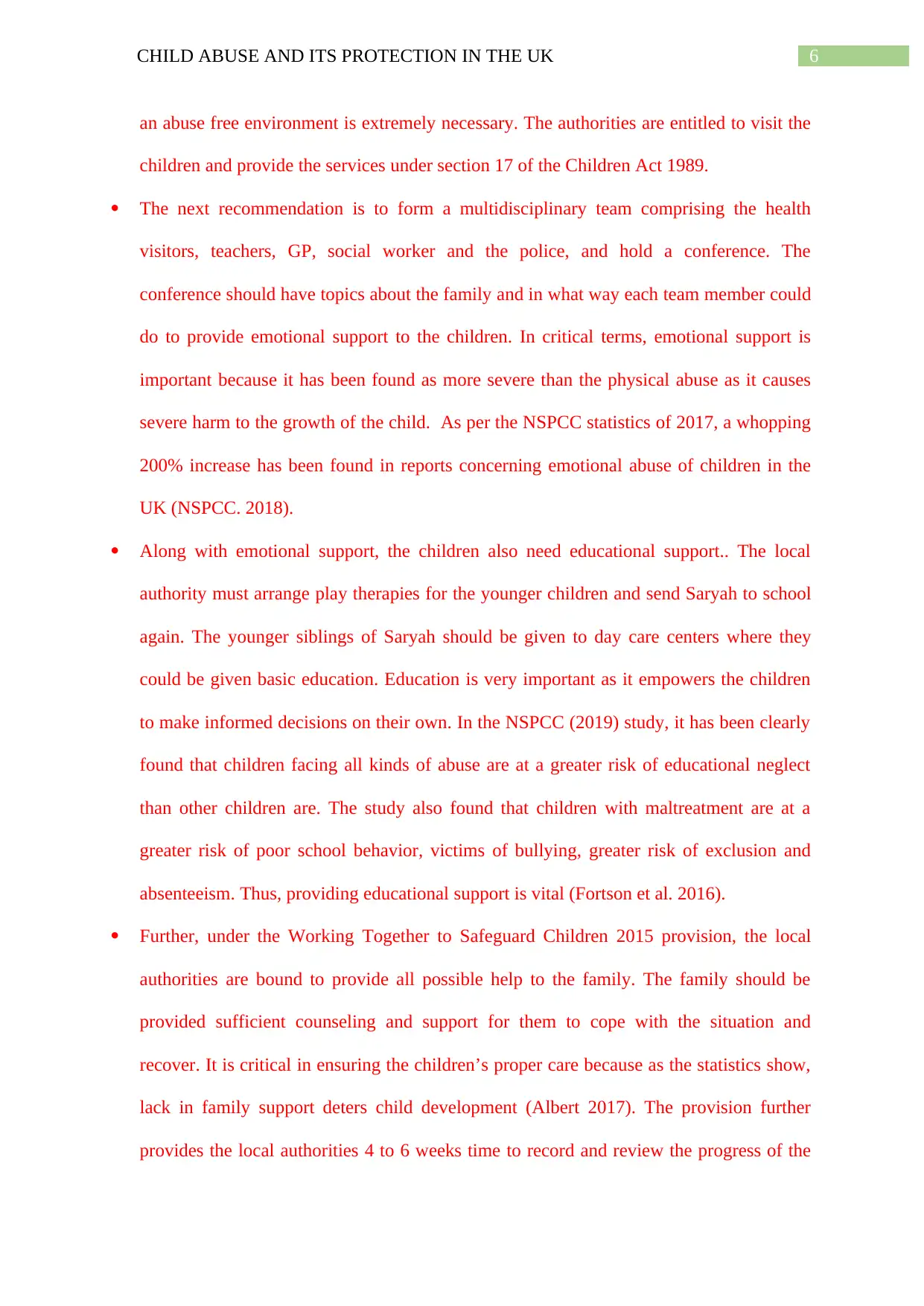
6CHILD ABUSE AND ITS PROTECTION IN THE UK
an abuse free environment is extremely necessary. The authorities are entitled to visit the
children and provide the services under section 17 of the Children Act 1989.
The next recommendation is to form a multidisciplinary team comprising the health
visitors, teachers, GP, social worker and the police, and hold a conference. The
conference should have topics about the family and in what way each team member could
do to provide emotional support to the children. In critical terms, emotional support is
important because it has been found as more severe than the physical abuse as it causes
severe harm to the growth of the child. As per the NSPCC statistics of 2017, a whopping
200% increase has been found in reports concerning emotional abuse of children in the
UK (NSPCC. 2018).
Along with emotional support, the children also need educational support.. The local
authority must arrange play therapies for the younger children and send Saryah to school
again. The younger siblings of Saryah should be given to day care centers where they
could be given basic education. Education is very important as it empowers the children
to make informed decisions on their own. In the NSPCC (2019) study, it has been clearly
found that children facing all kinds of abuse are at a greater risk of educational neglect
than other children are. The study also found that children with maltreatment are at a
greater risk of poor school behavior, victims of bullying, greater risk of exclusion and
absenteeism. Thus, providing educational support is vital (Fortson et al. 2016).
Further, under the Working Together to Safeguard Children 2015 provision, the local
authorities are bound to provide all possible help to the family. The family should be
provided sufficient counseling and support for them to cope with the situation and
recover. It is critical in ensuring the children’s proper care because as the statistics show,
lack in family support deters child development (Albert 2017). The provision further
provides the local authorities 4 to 6 weeks time to record and review the progress of the
an abuse free environment is extremely necessary. The authorities are entitled to visit the
children and provide the services under section 17 of the Children Act 1989.
The next recommendation is to form a multidisciplinary team comprising the health
visitors, teachers, GP, social worker and the police, and hold a conference. The
conference should have topics about the family and in what way each team member could
do to provide emotional support to the children. In critical terms, emotional support is
important because it has been found as more severe than the physical abuse as it causes
severe harm to the growth of the child. As per the NSPCC statistics of 2017, a whopping
200% increase has been found in reports concerning emotional abuse of children in the
UK (NSPCC. 2018).
Along with emotional support, the children also need educational support.. The local
authority must arrange play therapies for the younger children and send Saryah to school
again. The younger siblings of Saryah should be given to day care centers where they
could be given basic education. Education is very important as it empowers the children
to make informed decisions on their own. In the NSPCC (2019) study, it has been clearly
found that children facing all kinds of abuse are at a greater risk of educational neglect
than other children are. The study also found that children with maltreatment are at a
greater risk of poor school behavior, victims of bullying, greater risk of exclusion and
absenteeism. Thus, providing educational support is vital (Fortson et al. 2016).
Further, under the Working Together to Safeguard Children 2015 provision, the local
authorities are bound to provide all possible help to the family. The family should be
provided sufficient counseling and support for them to cope with the situation and
recover. It is critical in ensuring the children’s proper care because as the statistics show,
lack in family support deters child development (Albert 2017). The provision further
provides the local authorities 4 to 6 weeks time to record and review the progress of the
Paraphrase This Document
Need a fresh take? Get an instant paraphrase of this document with our AI Paraphraser
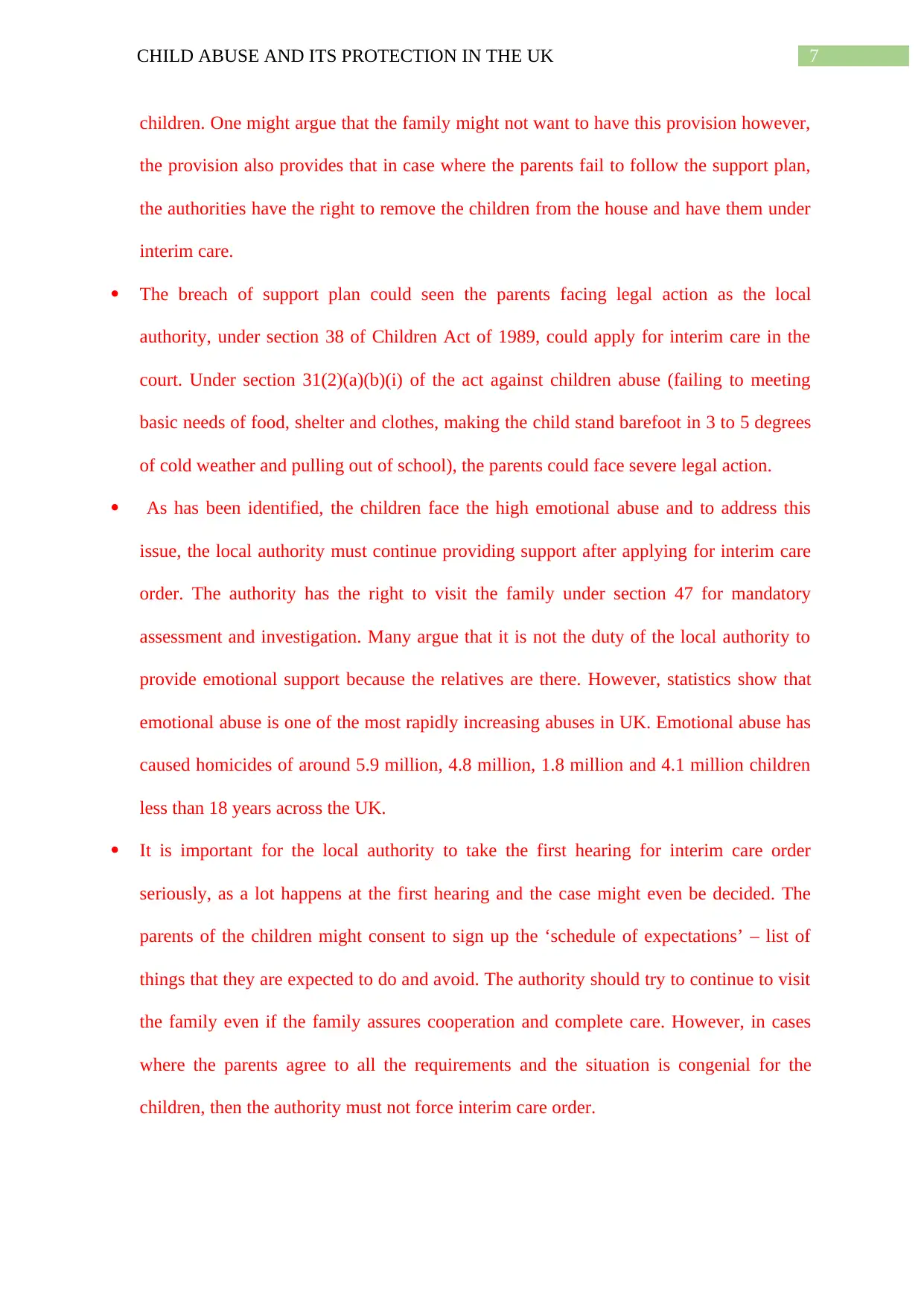
7CHILD ABUSE AND ITS PROTECTION IN THE UK
children. One might argue that the family might not want to have this provision however,
the provision also provides that in case where the parents fail to follow the support plan,
the authorities have the right to remove the children from the house and have them under
interim care.
The breach of support plan could seen the parents facing legal action as the local
authority, under section 38 of Children Act of 1989, could apply for interim care in the
court. Under section 31(2)(a)(b)(i) of the act against children abuse (failing to meeting
basic needs of food, shelter and clothes, making the child stand barefoot in 3 to 5 degrees
of cold weather and pulling out of school), the parents could face severe legal action.
As has been identified, the children face the high emotional abuse and to address this
issue, the local authority must continue providing support after applying for interim care
order. The authority has the right to visit the family under section 47 for mandatory
assessment and investigation. Many argue that it is not the duty of the local authority to
provide emotional support because the relatives are there. However, statistics show that
emotional abuse is one of the most rapidly increasing abuses in UK. Emotional abuse has
caused homicides of around 5.9 million, 4.8 million, 1.8 million and 4.1 million children
less than 18 years across the UK.
It is important for the local authority to take the first hearing for interim care order
seriously, as a lot happens at the first hearing and the case might even be decided. The
parents of the children might consent to sign up the ‘schedule of expectations’ – list of
things that they are expected to do and avoid. The authority should try to continue to visit
the family even if the family assures cooperation and complete care. However, in cases
where the parents agree to all the requirements and the situation is congenial for the
children, then the authority must not force interim care order.
children. One might argue that the family might not want to have this provision however,
the provision also provides that in case where the parents fail to follow the support plan,
the authorities have the right to remove the children from the house and have them under
interim care.
The breach of support plan could seen the parents facing legal action as the local
authority, under section 38 of Children Act of 1989, could apply for interim care in the
court. Under section 31(2)(a)(b)(i) of the act against children abuse (failing to meeting
basic needs of food, shelter and clothes, making the child stand barefoot in 3 to 5 degrees
of cold weather and pulling out of school), the parents could face severe legal action.
As has been identified, the children face the high emotional abuse and to address this
issue, the local authority must continue providing support after applying for interim care
order. The authority has the right to visit the family under section 47 for mandatory
assessment and investigation. Many argue that it is not the duty of the local authority to
provide emotional support because the relatives are there. However, statistics show that
emotional abuse is one of the most rapidly increasing abuses in UK. Emotional abuse has
caused homicides of around 5.9 million, 4.8 million, 1.8 million and 4.1 million children
less than 18 years across the UK.
It is important for the local authority to take the first hearing for interim care order
seriously, as a lot happens at the first hearing and the case might even be decided. The
parents of the children might consent to sign up the ‘schedule of expectations’ – list of
things that they are expected to do and avoid. The authority should try to continue to visit
the family even if the family assures cooperation and complete care. However, in cases
where the parents agree to all the requirements and the situation is congenial for the
children, then the authority must not force interim care order.
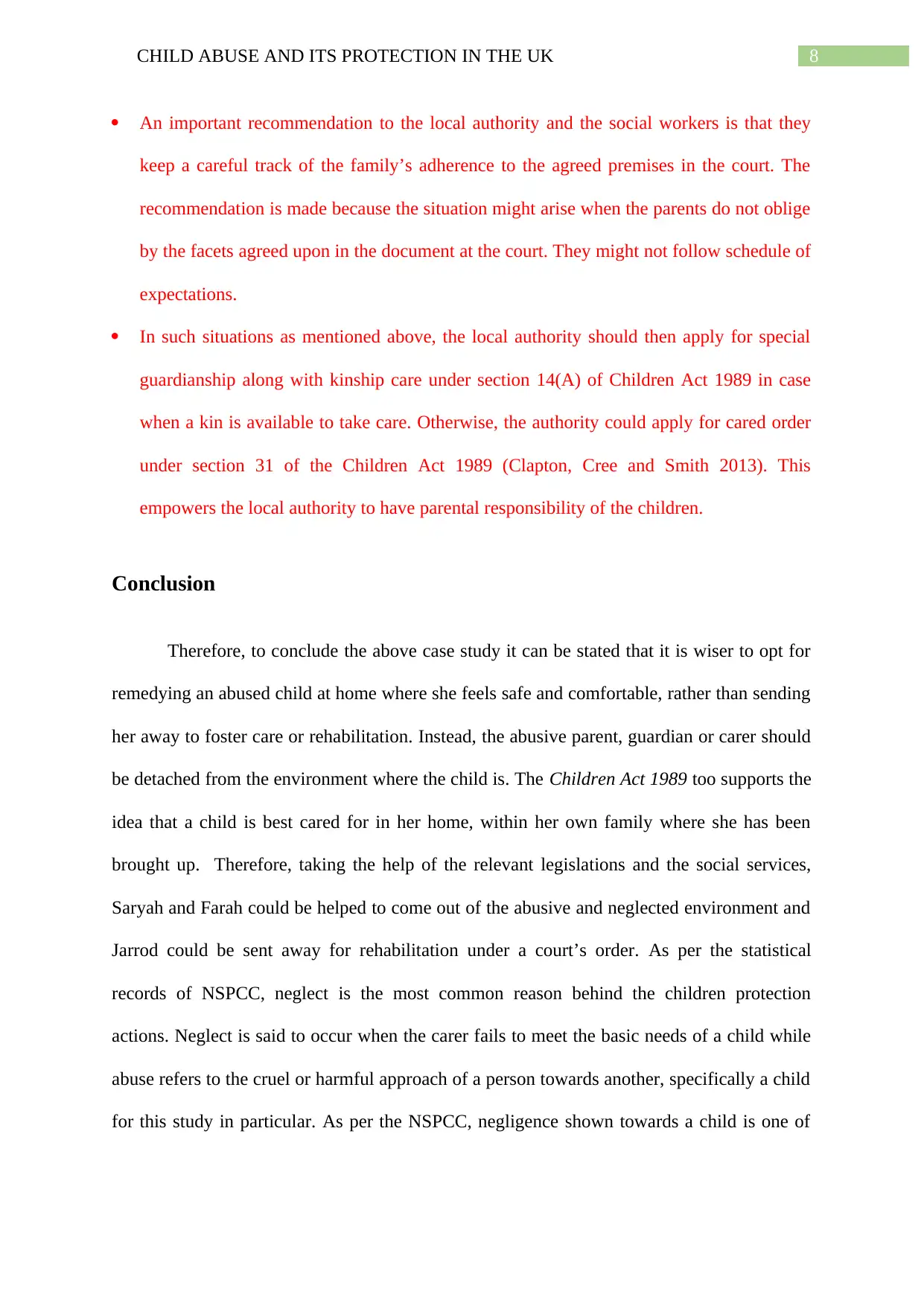
8CHILD ABUSE AND ITS PROTECTION IN THE UK
An important recommendation to the local authority and the social workers is that they
keep a careful track of the family’s adherence to the agreed premises in the court. The
recommendation is made because the situation might arise when the parents do not oblige
by the facets agreed upon in the document at the court. They might not follow schedule of
expectations.
In such situations as mentioned above, the local authority should then apply for special
guardianship along with kinship care under section 14(A) of Children Act 1989 in case
when a kin is available to take care. Otherwise, the authority could apply for cared order
under section 31 of the Children Act 1989 (Clapton, Cree and Smith 2013). This
empowers the local authority to have parental responsibility of the children.
Conclusion
Therefore, to conclude the above case study it can be stated that it is wiser to opt for
remedying an abused child at home where she feels safe and comfortable, rather than sending
her away to foster care or rehabilitation. Instead, the abusive parent, guardian or carer should
be detached from the environment where the child is. The Children Act 1989 too supports the
idea that a child is best cared for in her home, within her own family where she has been
brought up. Therefore, taking the help of the relevant legislations and the social services,
Saryah and Farah could be helped to come out of the abusive and neglected environment and
Jarrod could be sent away for rehabilitation under a court’s order. As per the statistical
records of NSPCC, neglect is the most common reason behind the children protection
actions. Neglect is said to occur when the carer fails to meet the basic needs of a child while
abuse refers to the cruel or harmful approach of a person towards another, specifically a child
for this study in particular. As per the NSPCC, negligence shown towards a child is one of
An important recommendation to the local authority and the social workers is that they
keep a careful track of the family’s adherence to the agreed premises in the court. The
recommendation is made because the situation might arise when the parents do not oblige
by the facets agreed upon in the document at the court. They might not follow schedule of
expectations.
In such situations as mentioned above, the local authority should then apply for special
guardianship along with kinship care under section 14(A) of Children Act 1989 in case
when a kin is available to take care. Otherwise, the authority could apply for cared order
under section 31 of the Children Act 1989 (Clapton, Cree and Smith 2013). This
empowers the local authority to have parental responsibility of the children.
Conclusion
Therefore, to conclude the above case study it can be stated that it is wiser to opt for
remedying an abused child at home where she feels safe and comfortable, rather than sending
her away to foster care or rehabilitation. Instead, the abusive parent, guardian or carer should
be detached from the environment where the child is. The Children Act 1989 too supports the
idea that a child is best cared for in her home, within her own family where she has been
brought up. Therefore, taking the help of the relevant legislations and the social services,
Saryah and Farah could be helped to come out of the abusive and neglected environment and
Jarrod could be sent away for rehabilitation under a court’s order. As per the statistical
records of NSPCC, neglect is the most common reason behind the children protection
actions. Neglect is said to occur when the carer fails to meet the basic needs of a child while
abuse refers to the cruel or harmful approach of a person towards another, specifically a child
for this study in particular. As per the NSPCC, negligence shown towards a child is one of
⊘ This is a preview!⊘
Do you want full access?
Subscribe today to unlock all pages.

Trusted by 1+ million students worldwide
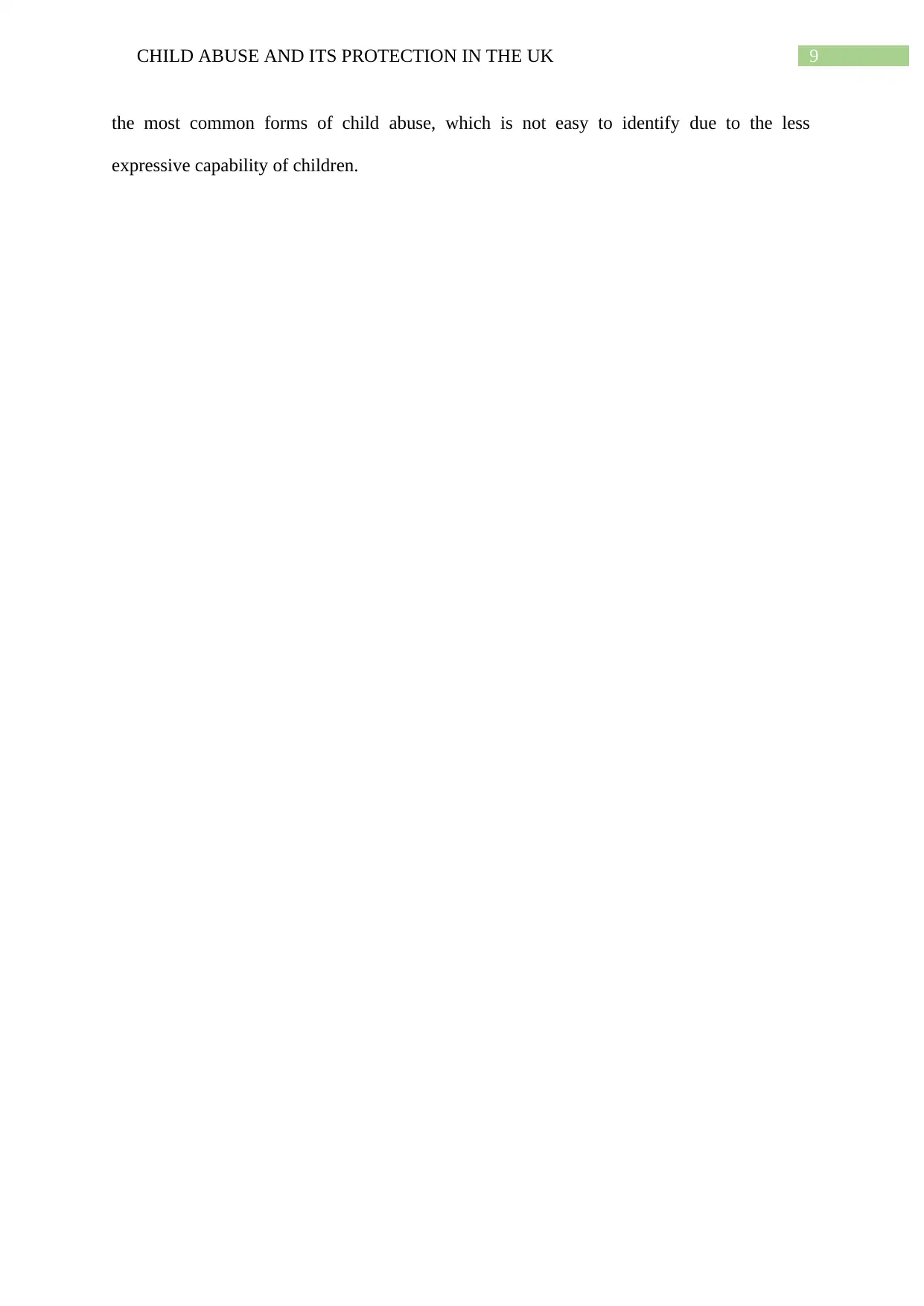
9CHILD ABUSE AND ITS PROTECTION IN THE UK
the most common forms of child abuse, which is not easy to identify due to the less
expressive capability of children.
the most common forms of child abuse, which is not easy to identify due to the less
expressive capability of children.
Paraphrase This Document
Need a fresh take? Get an instant paraphrase of this document with our AI Paraphraser
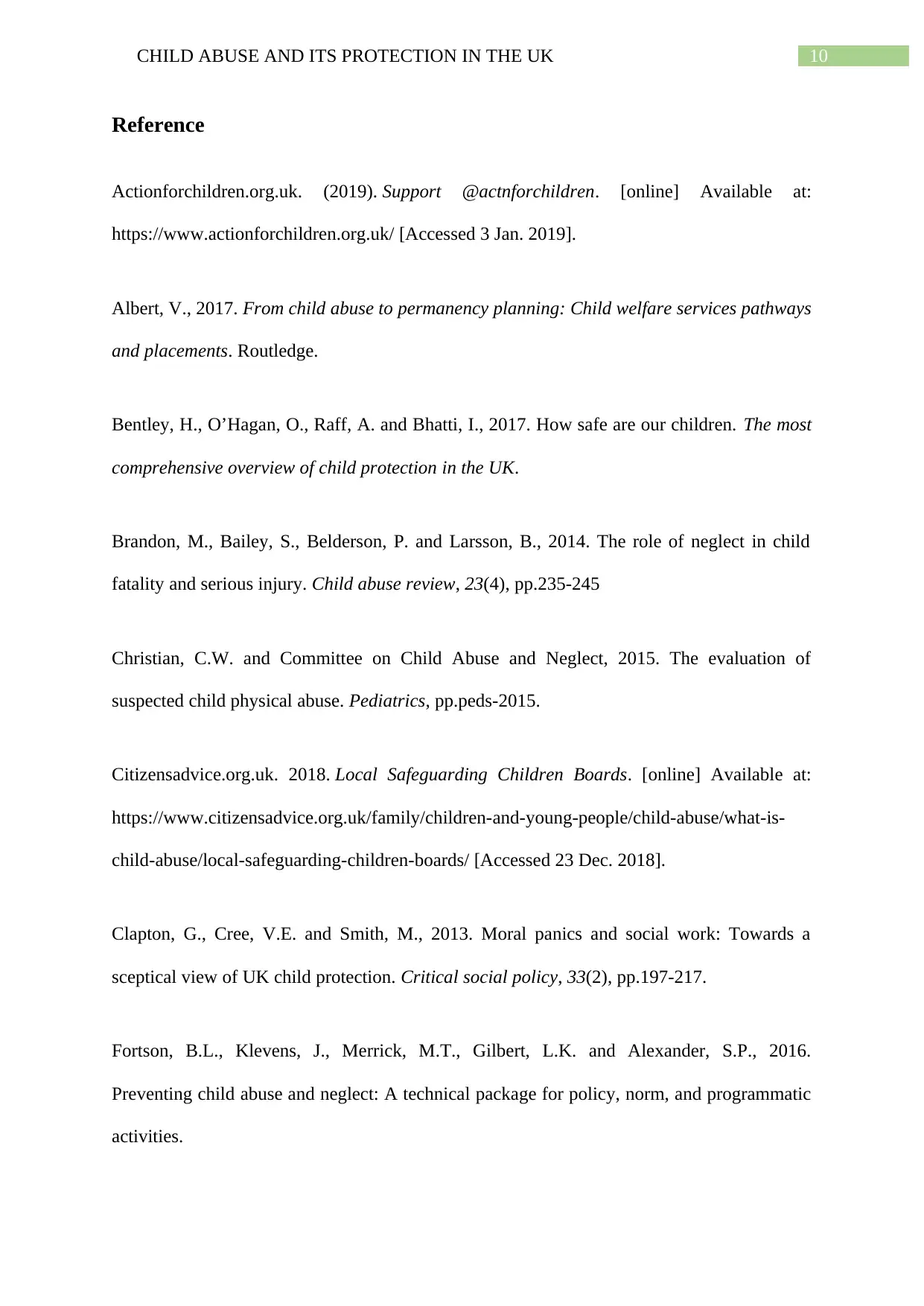
10CHILD ABUSE AND ITS PROTECTION IN THE UK
Reference
Actionforchildren.org.uk. (2019). Support @actnforchildren. [online] Available at:
https://www.actionforchildren.org.uk/ [Accessed 3 Jan. 2019].
Albert, V., 2017. From child abuse to permanency planning: Child welfare services pathways
and placements. Routledge.
Bentley, H., O’Hagan, O., Raff, A. and Bhatti, I., 2017. How safe are our children. The most
comprehensive overview of child protection in the UK.
Brandon, M., Bailey, S., Belderson, P. and Larsson, B., 2014. The role of neglect in child
fatality and serious injury. Child abuse review, 23(4), pp.235-245
Christian, C.W. and Committee on Child Abuse and Neglect, 2015. The evaluation of
suspected child physical abuse. Pediatrics, pp.peds-2015.
Citizensadvice.org.uk. 2018. Local Safeguarding Children Boards. [online] Available at:
https://www.citizensadvice.org.uk/family/children-and-young-people/child-abuse/what-is-
child-abuse/local-safeguarding-children-boards/ [Accessed 23 Dec. 2018].
Clapton, G., Cree, V.E. and Smith, M., 2013. Moral panics and social work: Towards a
sceptical view of UK child protection. Critical social policy, 33(2), pp.197-217.
Fortson, B.L., Klevens, J., Merrick, M.T., Gilbert, L.K. and Alexander, S.P., 2016.
Preventing child abuse and neglect: A technical package for policy, norm, and programmatic
activities.
Reference
Actionforchildren.org.uk. (2019). Support @actnforchildren. [online] Available at:
https://www.actionforchildren.org.uk/ [Accessed 3 Jan. 2019].
Albert, V., 2017. From child abuse to permanency planning: Child welfare services pathways
and placements. Routledge.
Bentley, H., O’Hagan, O., Raff, A. and Bhatti, I., 2017. How safe are our children. The most
comprehensive overview of child protection in the UK.
Brandon, M., Bailey, S., Belderson, P. and Larsson, B., 2014. The role of neglect in child
fatality and serious injury. Child abuse review, 23(4), pp.235-245
Christian, C.W. and Committee on Child Abuse and Neglect, 2015. The evaluation of
suspected child physical abuse. Pediatrics, pp.peds-2015.
Citizensadvice.org.uk. 2018. Local Safeguarding Children Boards. [online] Available at:
https://www.citizensadvice.org.uk/family/children-and-young-people/child-abuse/what-is-
child-abuse/local-safeguarding-children-boards/ [Accessed 23 Dec. 2018].
Clapton, G., Cree, V.E. and Smith, M., 2013. Moral panics and social work: Towards a
sceptical view of UK child protection. Critical social policy, 33(2), pp.197-217.
Fortson, B.L., Klevens, J., Merrick, M.T., Gilbert, L.K. and Alexander, S.P., 2016.
Preventing child abuse and neglect: A technical package for policy, norm, and programmatic
activities.
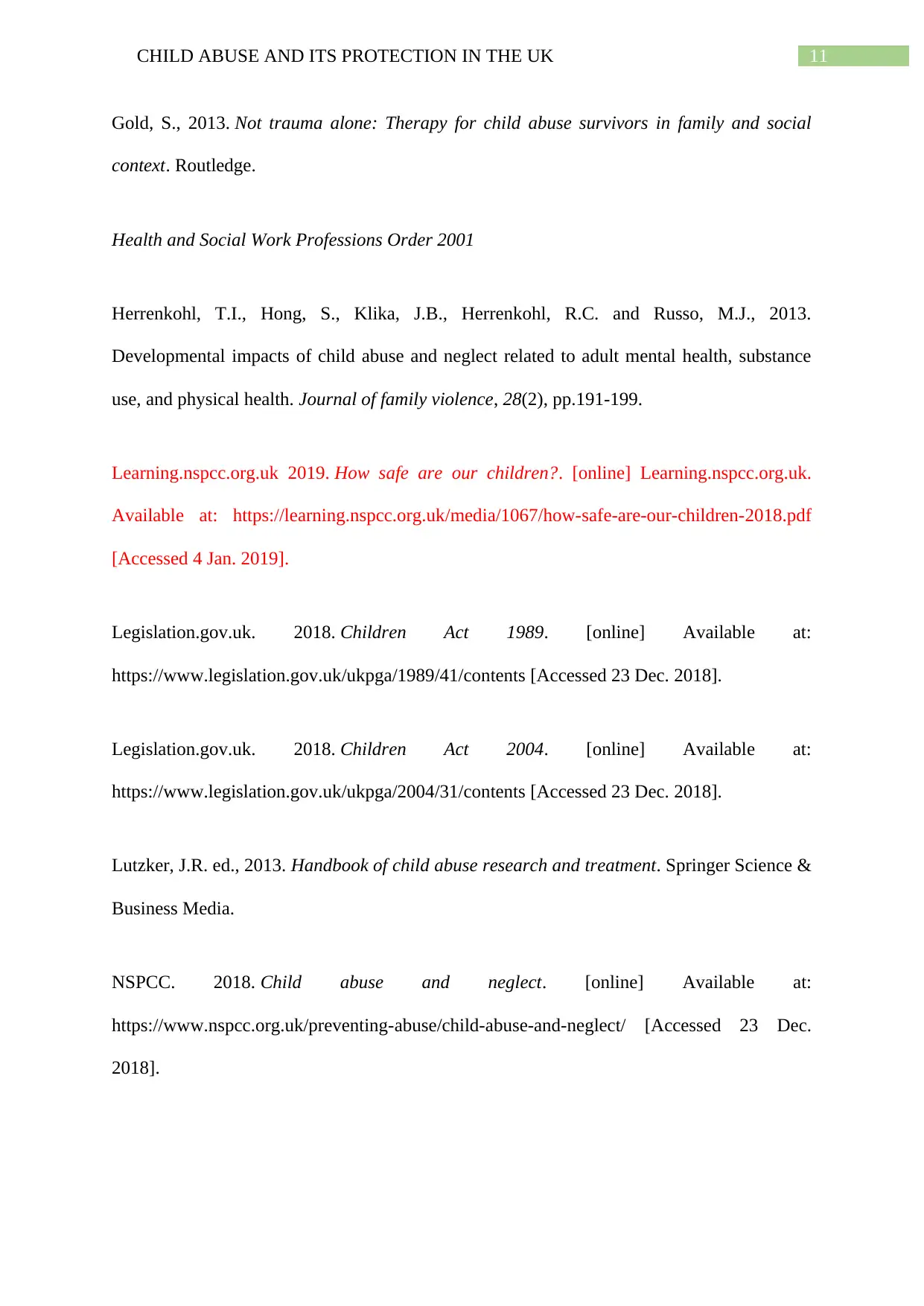
11CHILD ABUSE AND ITS PROTECTION IN THE UK
Gold, S., 2013. Not trauma alone: Therapy for child abuse survivors in family and social
context. Routledge.
Health and Social Work Professions Order 2001
Herrenkohl, T.I., Hong, S., Klika, J.B., Herrenkohl, R.C. and Russo, M.J., 2013.
Developmental impacts of child abuse and neglect related to adult mental health, substance
use, and physical health. Journal of family violence, 28(2), pp.191-199.
Learning.nspcc.org.uk 2019. How safe are our children?. [online] Learning.nspcc.org.uk.
Available at: https://learning.nspcc.org.uk/media/1067/how-safe-are-our-children-2018.pdf
[Accessed 4 Jan. 2019].
Legislation.gov.uk. 2018. Children Act 1989. [online] Available at:
https://www.legislation.gov.uk/ukpga/1989/41/contents [Accessed 23 Dec. 2018].
Legislation.gov.uk. 2018. Children Act 2004. [online] Available at:
https://www.legislation.gov.uk/ukpga/2004/31/contents [Accessed 23 Dec. 2018].
Lutzker, J.R. ed., 2013. Handbook of child abuse research and treatment. Springer Science &
Business Media.
NSPCC. 2018. Child abuse and neglect. [online] Available at:
https://www.nspcc.org.uk/preventing-abuse/child-abuse-and-neglect/ [Accessed 23 Dec.
2018].
Gold, S., 2013. Not trauma alone: Therapy for child abuse survivors in family and social
context. Routledge.
Health and Social Work Professions Order 2001
Herrenkohl, T.I., Hong, S., Klika, J.B., Herrenkohl, R.C. and Russo, M.J., 2013.
Developmental impacts of child abuse and neglect related to adult mental health, substance
use, and physical health. Journal of family violence, 28(2), pp.191-199.
Learning.nspcc.org.uk 2019. How safe are our children?. [online] Learning.nspcc.org.uk.
Available at: https://learning.nspcc.org.uk/media/1067/how-safe-are-our-children-2018.pdf
[Accessed 4 Jan. 2019].
Legislation.gov.uk. 2018. Children Act 1989. [online] Available at:
https://www.legislation.gov.uk/ukpga/1989/41/contents [Accessed 23 Dec. 2018].
Legislation.gov.uk. 2018. Children Act 2004. [online] Available at:
https://www.legislation.gov.uk/ukpga/2004/31/contents [Accessed 23 Dec. 2018].
Lutzker, J.R. ed., 2013. Handbook of child abuse research and treatment. Springer Science &
Business Media.
NSPCC. 2018. Child abuse and neglect. [online] Available at:
https://www.nspcc.org.uk/preventing-abuse/child-abuse-and-neglect/ [Accessed 23 Dec.
2018].
⊘ This is a preview!⊘
Do you want full access?
Subscribe today to unlock all pages.

Trusted by 1+ million students worldwide
1 out of 13
Related Documents
Your All-in-One AI-Powered Toolkit for Academic Success.
+13062052269
info@desklib.com
Available 24*7 on WhatsApp / Email
![[object Object]](/_next/static/media/star-bottom.7253800d.svg)
Unlock your academic potential
Copyright © 2020–2025 A2Z Services. All Rights Reserved. Developed and managed by ZUCOL.




